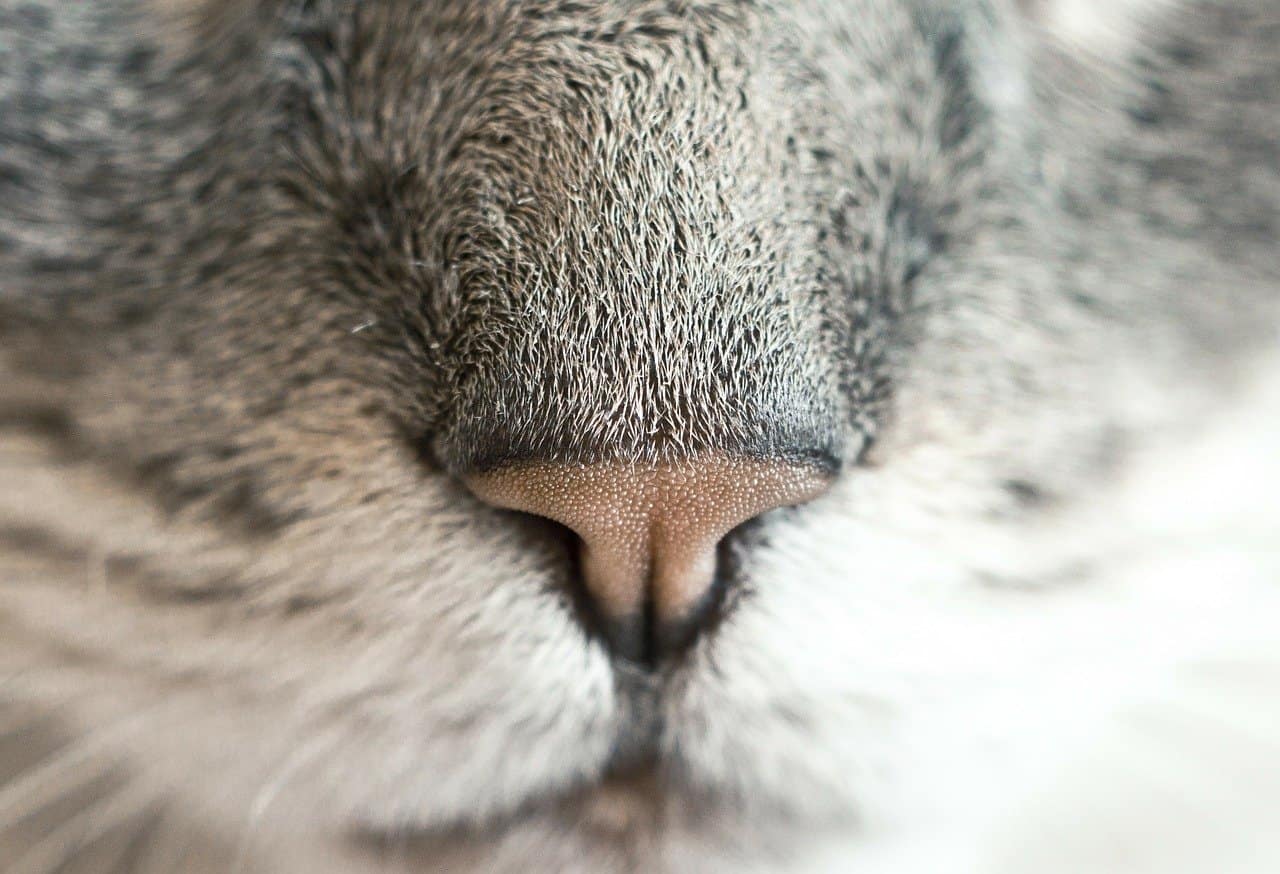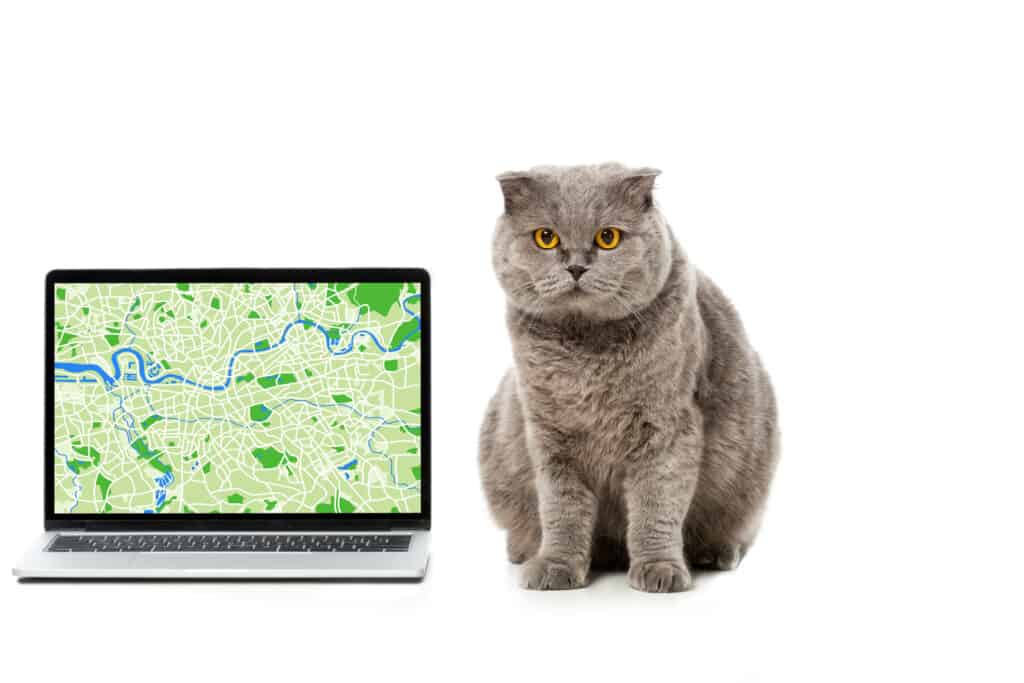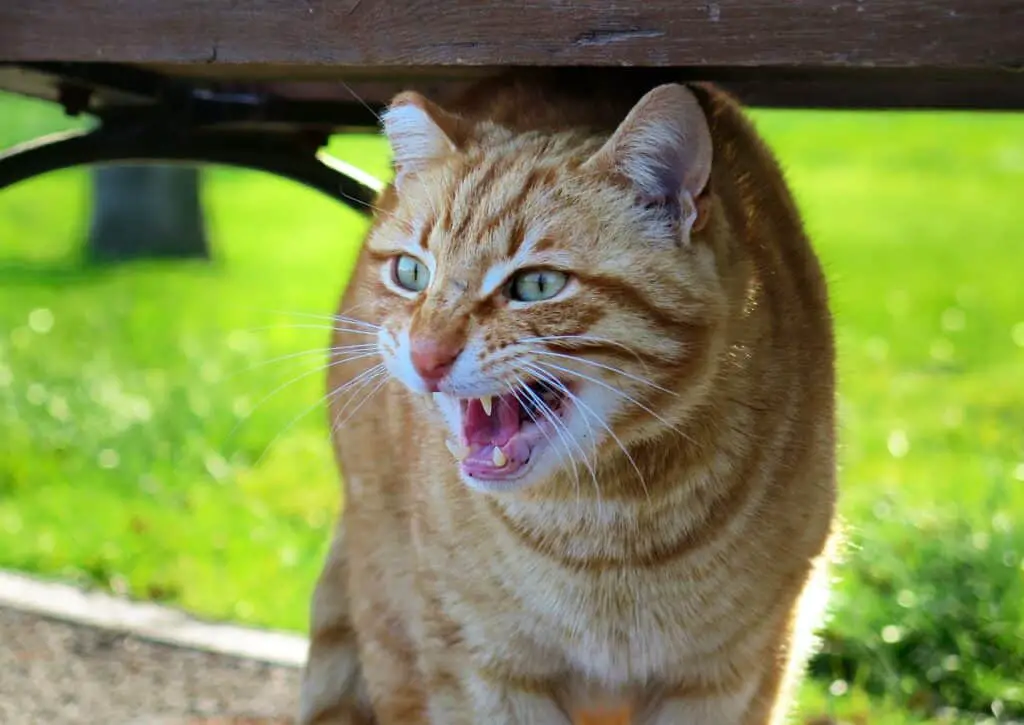We know how mysterious cats can be. And we’re not talking only about their quirky and funny behavior, most of us wonder how their tiny bodies can be so effective in a lot of things. Although it’s well known that dogs have a superior sense of smell, the delicate nose of a cat is an essential instrument in its survival. So, today we’ll have a look at it and answer a question we hear often;
“How far away can cats smell?”
Cats have an acute sense of smell and are able to pick up scents from as far as 1.5 to 4 miles (2.4 – 6.4km). Cats have over 200 million odor sensors on their noses, by far exceeding the 5 million odor sensors that humans have. Because of this, a cat’s sense of smell is 14 times stronger than that of an average human.
Now imagine if you could smell as well as a cat, you’d be able to pick up scents from blocks away. This seems almost impossible but it’s a superpower that cats depend on for their survival.
Why?
Keep reading and find out!
How sensitive is a cat’s nose and why
A cat has over 200 million odor sensors on its nose, which isn’t as much as dogs who can have as many as 300 million odor sensors but still, it provides cats with superior smelling abilities. And, whether their nose is black or pink, they can pick up scents that stay hidden for us simple humans.
Evolution
Cats are predators and they depend on their noses for survival. Even though modern cats don’t depend as much on their noses to find food or safety, they still possess many features from their wild ancestors. The reason for this is that cats are domesticated differently compared to dogs.
Dogs have lost most of their wild instincts and are completely dependent on humans. Cats, on the other hand, aren’t fully domesticated and have retained a lot of their superpowers from the days they lived in the wild, away from humans.
What about their vision?
I’m sure some of you might be thinking by now: “aren’t cats mostly dependent on their eyes instead of their sense of smell?”.
Although cats do have excellent night vision, they are very nearsighted and their vision is actually inferior to most humans.
An average human’s vision is 20/20. For cats, this is more like 20/100 to 20/200. This means that a cat needs to be at 20 feet to see what a human can see at a distance of 100-200 feet. Because of this, they depend a lot on their noses.
How far away can cats smell?
It’s difficult to determine exactly how far away cats can detect scents. That’s because cats are usually hard to study. However, one study claims that cats have the ability to find their way back home from a distance of 1.5 to 4 miles (2.4 to 6.4 km).
The reason for their good sense of direction is believed to be due to their well-developed nasal organ.
Another superpower
Apart from the millions of odor sensors in their noses, cats have such a strong sense of smell thanks to their Jacobson’s Organ (aka Vomeronasal Organ)
Many mammals, including humans, possess a Jacobson’s organ. This organ is located in the base of the nasal cavity and assists the odor receptors in our noses to increase the sensitivity to odors.
It helps us (and cats) to taste the air, rather than smell it. You can see this when sometimes if cats want to smell something better, they open their mouth slightly to pass the air via their Jacobson Organ.
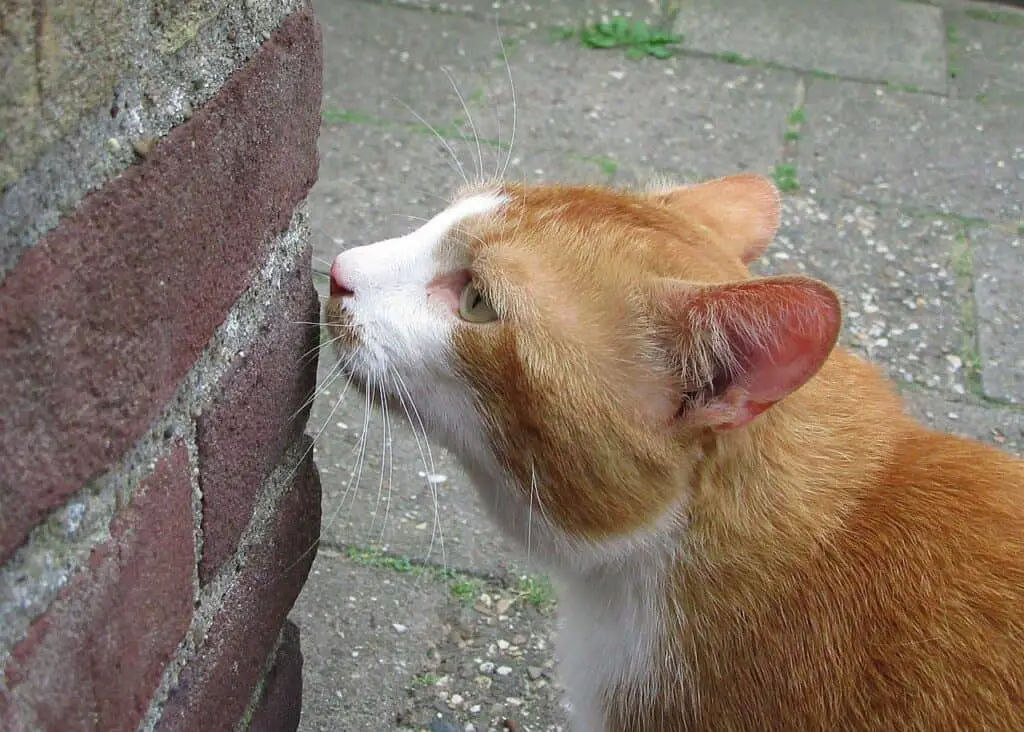
Why is smell important to cats?
Apart from their vision, the sense of smell is one of the most important cat senses because it provides them with essential information about their environment. It helps them to find food, water, find a mate, and recognize danger. Cats use scents in the form of pheromones; to mark their territory and belongings.
Like humans, cats can form associations with scents, form memories based on odors, and associate them with places, types of food, and specific humans or animals.
Fun Fact: Cats recognize you by how you smell, rather than your looks.
A cat’s sense of smell plays a major part in its life. Let’s look at the most important ones.
Food
A cat’s dependence on its nose starts directly from birth. Kittens are born blind and they have to use their sense of smell to find their mother’s milk.
Cats are also really good at recognizing certain smells. Once it’s in their ‘scent database’, they will go through great lengths to find an item once they’ve smelled something they like.
They can even smell their favorite foods while it’s still in your shopping bag or when you start preparing it for them. Or, in the wild, cats will use their nose to pick up the scents of prey or other food sources.
Taste with their nose
But their sense of taste, however, isn’t as strong as their sense of smell. Cats have less than 500 taste buds compared to the 9,000 taste buds that humans have but their noses help them out here and assist their tongues in tasting their food.
Cat owners will definitely have noticed their cats carefully smelling their food before tasting it. Because their sense of smell plays such a large role in a cat’s ability to taste their food, it will cause them to lose their appetite when they have a reduced sense of smell due to aging or breathing issues.
Finding a mate
A cat’s incredible sense of smell also plays a major part in finding a mate.
Female cats in heat produce a strong sex pheromone for male cats to smell. This pheromone travels through the air and males can smell from up to a mile away.
This is why boy cats can flood a neighborhood in droves when there’s even just one female in heat.
On the other hand, it’s not uncommon for females to go looking for a male by sniffing out their territorial scents as well.
That’s why it’s recommended for both male and female cats to get neutered or spayed before they reach maturity. Male cats will start marking their territory inside your home. Sexually mature cats are also more likely to escape home and find a cat to mate. Neutering your cat will solve this issue.
Territory
Male cats can be territorial. They mark their territory with scent markings like urine or by spreading pheromones produced by glands at the side of their face, and their paws onto objects. They do this basically to tell other cats “this is mine”. Other cats that do not heed this warning might be in for a fight.
All cats can pick up territorial scents from other cats and decide what to do about it, fight for territory, or simply leave.
This is also the reason why domestic cats love rubbing themselves on their owners or their owner’s belongings and even their favorite humans. It’s a way to declare that you are part of their territory.
It’s not uncommon for cats to sniff their owners after they come home as if saying “I smell you differently”. That happens because every time you go out and touch another animal, they know what you did. Usually, after sniffing, they will rub themselves against you to eliminate unknown smells.
Danger
New odors can be a sign of danger for a cat. In the wild, a strange odor could mean that there’s a big predator around or that it might have wandered in another cat’s territory.
Their noses play a vital role in detecting possible threats, in combination with their other senses.
When it comes to their noses, a cat’s understanding of the world is based on the smells around them. Sometimes they can find it hard to adapt to a new environment because of the new smells in it.
So, if you’re adopting a new cat or moving to a new home, you’ll need to give your feline friend some time to get used to all the new smells.
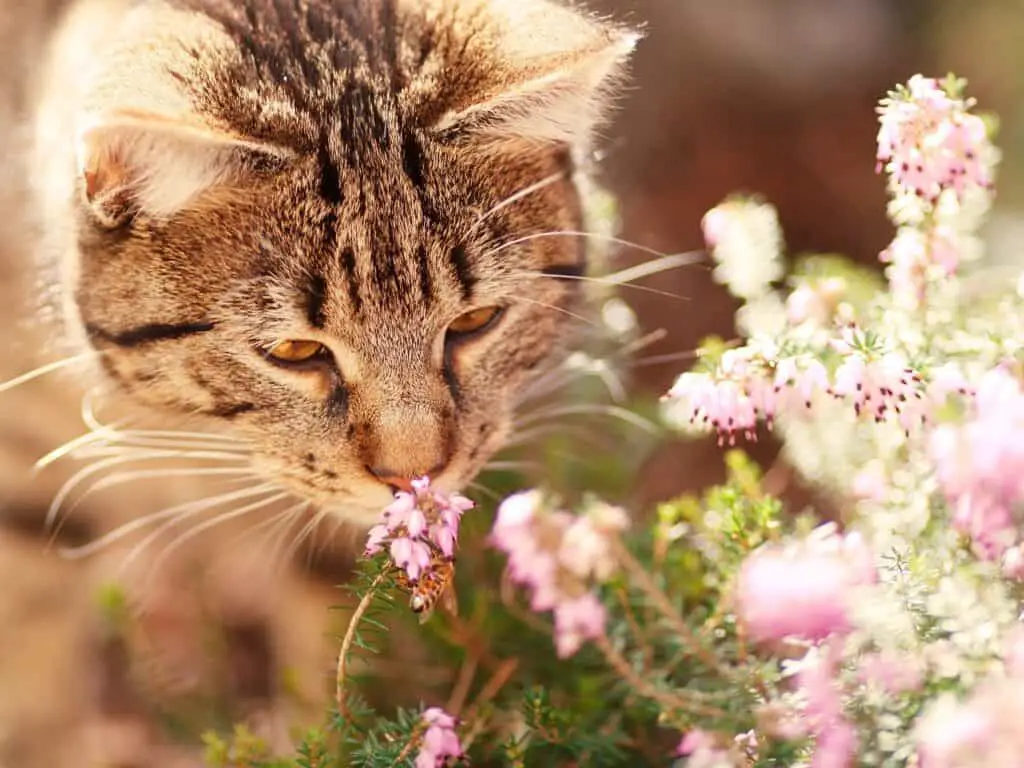
What about a cat’s other senses?
Cats, just like any other animal, build a mental picture of the world around them why combining input from all their senses.
We know that a cat’s senses are uniquely tuned to survival in the wild and even our domesticated kitties still possess these abilities.
Cats discover their world with the help of their whiskers, their sensitive hearing, unparalleled night vision, and their sense of smell.
Although cats are most renowned for their night vision, their eyes are actually not their best senses.
Sight – We all know that cats can see exceptionally well in the dark. They also have a much wider field of vision than humans; about 200 degrees compared to our 180 degrees. They are, however, quite near-sighted and they don’t perceive colors as vivid as we do.
That’s why cats mostly depend on their other senses for hunting.
Touch – The whiskers on their face and paws let them perceive objects in their environment like radar. Especially for nearby objects, their whiskers play an equally important role as their eyes.
Hearing – Their ears can rotate up to 180 degrees to where any threatening sound is coming from. Cats also have a hearing range of 45-85,000 Hz, making it one of the broadest hearing ranges among mammals. By comparison, humans can only hear sounds within the range of 20-20,000 Hz.
Do cats use their sense of smell to navigate?
It’s a well-known fact that cats are good at navigating and finding their way home.
The mechanics behind this homing instinct are still unclear to the scientific community. That’s mainly because there isn’t too much research on cats’ abilities to orientate themselves.
As of today, there are only theories about how cats navigate and find their way home. One of the theories states that cats may be able to feel the Earth’s magnetic field and navigate using it.
More likely is that a cat’s senses, as well as its intellect, play an important role in its navigational abilities. It’s almost certain that a cat’s nose plays an important role in recognizing scent markings in their surroundings which helps them to build a mental map of their surroundings.
It’s important to note that indoor cats are way less experienced at navigating than outdoor cats that constantly navigate and live on the street. If a domestic indoor cat ever escapes, it probably won’t go very far away. It’s important to pay attention to your cats to prevent them from escaping.
How does a cat’s sense of smell compare with a dog?
Cats and dogs are two pets that are famous for their strong sense of smell, but how do they compare?
Cats have over 200 million scent receptors in their noses and the number of scent receptors in dogs varies depending on the breed.
Most dog breeds have around 150 million scent receptors; others like the German Shepherd or Beagles have around 225 million. Bloodhounds win this battle with around 300 million odor receptors on their nose.
Another factor to take into consideration is the types of proteins found in vomeronasal organs. The protein V1R is the one responsible for helping us differentiate one smell from another. Humans have two forms of this V1R protein, dogs have about nine, and cats have thirty variations.
Here is a nice article that describes this and even asks the question of whether cats can replace search-and-rescue dogs
It’s somehow not surprising to see that cats have a larger quantity of this protein, considering how much they depend on their sense of smell.
Can cats recognize their owners’ scent?
Absolutely! Cats recognize their owner by their smell. They can even smell a lot of what you’ve been up to during your day when you come home to your trusted feline friend.
Every human produces a unique scent that is made up of sweat, perfume, and oils on our skin. Cats can pick up these scents and recognize you. If cats ever smell something different on you, they will rub you with their pheromone glands to mark you as their own.
Cats can also pick up on the subtle changes in our chemical makeup, caused by human hormones. They can sense pregnancy and changes in your mood. Cats can even tell when a woman is on her period.
Experts suggest that cats use a lot of cues to determine how their humans are feeling. From your expressions to your posture, to the hormones you naturally produce.
What smells are cats attracted to?
There are many smells that cats love. They’re mostly plants and natural stuff, so you can find these elements at most grocery stores.
If you want to play with your cat and stimulate their sense of smell, it can be a great idea to get one of the following things:
- Honeysuckle’s flowers.
- Basil.
- Olive.
- Catnip.
- Valerian Root.
- Silvervine.
You probably already know what catnip does to cats, but all of these scents will give your cat a good aroma to have fun with. But remember, every cat is different and yours may or may not like these specific smells.
If you were wondering about smells that cats hate, have a look at our article right here; they hate cleaning products that smell too strong, certain perfumes, and cigarette smoke.
When introducing your cat to a new smell, it’s best to do it gradually.
New smells can scare cats, so take that into consideration. Cats can form experiences and associate them to smells, so if you want them to have a positive experience then expose them to new smells at their own pace and make it an enjoyable experience for them.

